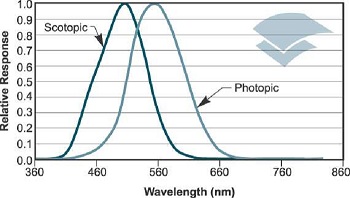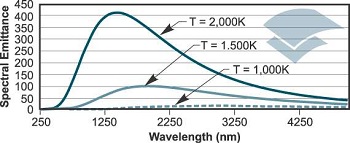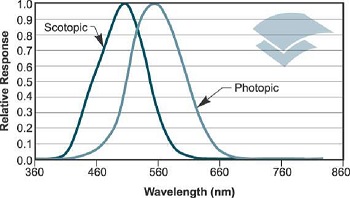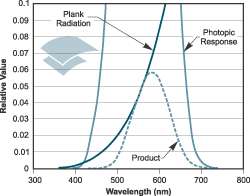Resources
 Part of the Oxford Instruments Group
Part of the Oxford Instruments Group
Expand
Collapse
 Part of the Oxford Instruments Group
Part of the Oxford Instruments Group
What is Radiometry?
Radiometry is the science of measuring light in any portion of the electromagnetic spectrum. In practice, the term is usually limited to the measurement of infrared, visible and ultraviolet light using optical instruments. Irradiance is the intensity of light and is measured in watts per square meter.
What is Photometry?
Photometry is the science of measuring visible light in units that are weighted according to the sensitivity of the human eye. It is a quantitative science based on a statistical model of the human visual response to light - that is, our perception of light - under carefully controlled conditions. The photometric equivalent of Radiance is called Illuminance and is measured in Lumens per square meter (Lux).
The human visual system
The human visual system responds to the light in the electromagnetic spectrum with wavelengths ranging from 380 to 770 nanometers (nm). We see light of different wavelengths as a continuum of colors ranging through the visible spectrum: 650 nm is red, 540 nm is green, 450 nm is blue, and so on.
The sensitivity of the human eye to light varies with wavelength. A light source with an irradiance of one Watt/m² of green light, for example, appears much brighter than the same source with an irradiance of one Watt/m² of red or blue light. In photometry, we do not measure Watts of radiant energy. Rather, we attempt to measure the subjective impression produced by stimulating the human eye-brain visual system with radiant energy.

This task is complicated immensely by the eye's nonlinear response to light. It varies not only with wavelength but also with the amount of radiant flux, whether the light is constant or flickering, the spatial complexity of the scene being perceived, the adaptation of the iris and retina, the psychological and physiological state of the observer and a host of other variables
Nevertheless, the subjective impression of seeing can be quantified for "normal" viewing conditions. In 1924, the Commission Internationale d’Eclairage (International Commission on Illumination, or CIE) asked over one hundred observers to visually match the "brightness" of monochromatic light sources with different wavelengths under controlled conditions. Taking an average of the measurements results in the so called Photopic response of the perceived ‘average’ human observer as shown in graph below:

The curve on the left shows the response to low levels of light. The shift in sensitivity occurs because two types of photoreceptors, cones and rods, are responsible for the eye's response to light. The curve on the right shows the eye's response under normal lighting conditions and this is called the Photopic response. The cones respond to light under these conditions and they are also responsible for human color perception.
The curve on the left shows the eyes response to low levels of light and is called the Scotopic response. At low level of light, the rods are most active and the human eye is more sensitive to any amount of light that is present, but is less sensitive to the range of color. Rods are highly sensitive to light but are comprised of a single photo pigment, which accounts for the loss in ability to discriminate color.
The conversion between photometric units which take into account human physiology and straight radiometric units is given by the following: (photometric unit) = (radiometric unit) x (683) x V(?)where V(?) is the 'Photopic Response,' shown earlier and basically tells us how efficiently the eye picks up certain wavelengths of light.
The Photopic response is a function of the wavelength of light and so to convert from radiometric units to photometric units first requires knowledge of the light source. If the source is specified as having a certain color temperature we can assume that its spectral radiance emittance is the same as a perfect black body radiator and use Planck’s law defined earlier.

Artificial sources in general do not have the same spectral distribution as a perfect black body but for our purposes we shall consider them equal. The graph above depicts the spectral radiance of several black body radiators. If we consider the Photopic evaluation of a black body radiation at a temperature of T=2045K.


Integration of the product of the light emittance by the Photopic function provides the conversion from a Radiometric signal to a Photometric.
Explore our range of related products below...
